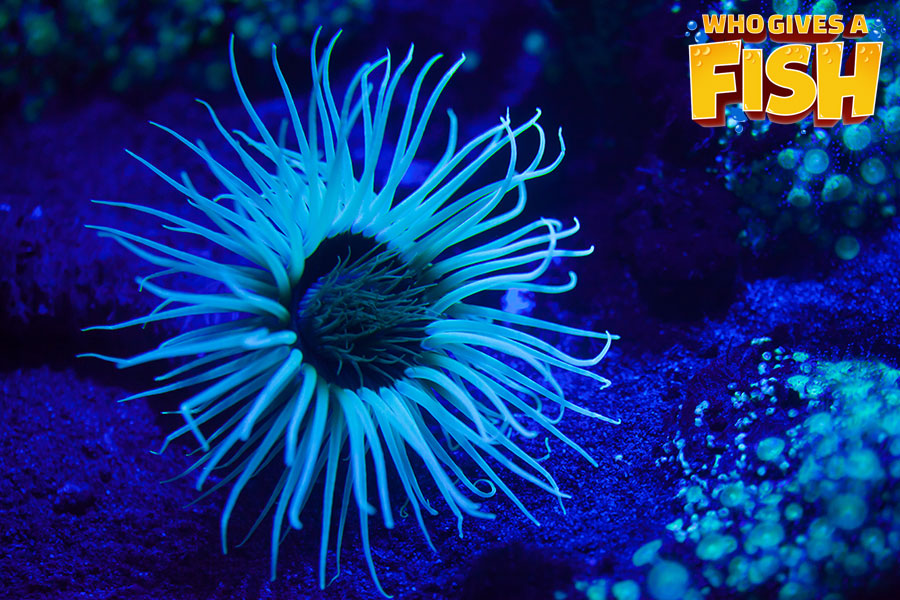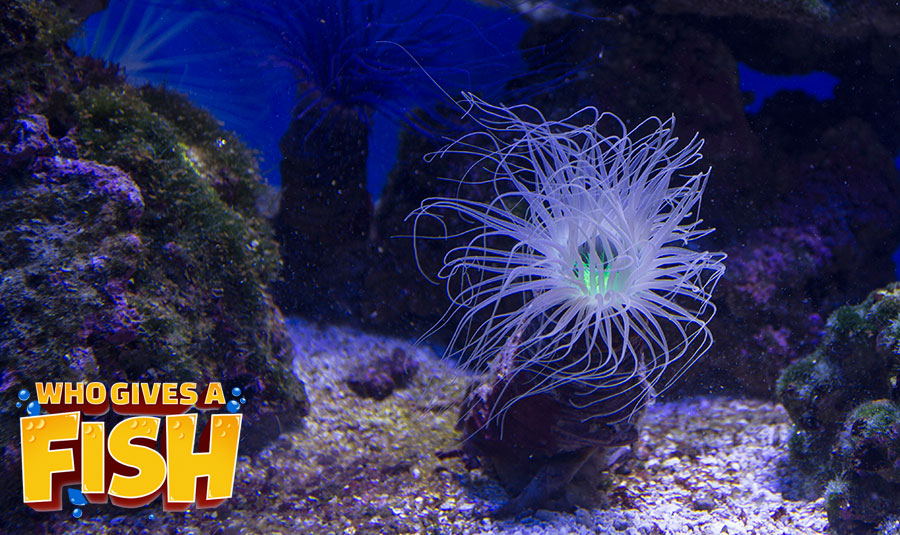Tube Anemone
The Tube Anemone, Cerianthus membranaceus, also known as the Tube Dwelling Anemone is a specimen with some very interesting traits. It is known to be a hardy coral paired with a beautiful color which makes it a heavily sought-after coral. They can withstand a fairly wide range of temperatures, moderate filtration and some subdued lighting.
- Experience Level: Intermediate
- Hardiness: Moderate
- Minimum Tank Size: 50 gal (190 L)
- Lighting Needs: Strong lighting
- Temperature: 72° – 83° F (22.2° – 28° C)
- Gravity: 1.023 – 1.025
Table of Contents
Introduction
Aquarium Setup
Difficulty
Feeding
Breeding
Social
It is a large anemone, reaching up to 8” (20 cm) wide, with tentacles that can extend out to 12” inches (30.5 cm) or even more. It can spread its long tentacles out over the surface of the sand or mud in order to catch prey.
A decent sized aquarium is needed to house one of these anemones due to its expansive size and its special burrowing behavior. They are also known to produce a lot of waste from excretions of tube slime.
They have a soft, long and cylindrical body shape. Their body is topped with a non-retractable crown made of tentacles on the one end, and a foot that is pointed on the other. It uses this pointed foot to burrow deep down into substrates made of mud or sand, only leaving its oral disc and tentacles exposed to the surface. Once they have fixed themselves into the substrate, the Tube Dwelling Anemone will construct a hard tube to live in.
It was once thought that these anemones created these tubes by releasing mucous which was eventually covered in sand. However, today is it known that these tubes are created by releasing threads made of a special type of nematocyst which are called ‘ptychocyst’. This process results in structures of woven fibrous stinging cells that will protect the anemone from being attacked. Even though its tentacles are not able to be retracted, if it feels threatened it can quickly withdraw its entire body inside the tube, becoming completely hidden.
The Tube Anemone is also known as the Colored Tube Anemone as it can be seen in many different fluorescent hues and color combinations. The Tube Anemone, unlike many true anemones is rarely artificially colored through dyes- its natural color is so strong its never required.
Ensure you provide your anemone with plenty of space in the aquarium to prevent other corals being stung by it. In the wild, some species of burrowing anemones have been seen living commensally with a range of worms and crustaceans. In the aquarium however, this possibility is limited. Some Tube Anemone species can be housed in large tanks but are not compatible with other anemone species. You should not house them with snails, lobsters, large crabs, large Angelfish or Triggerfish.
Aquarium Setup
A typical reef setup is required to house a Tube Anemone, along with some good sand substrate. It does however need to be a cold-water tank. Investing in a good chiller is advised before attempting to house one of these anemones. You should have a well-established tank of at least 50 gallons and of at least 9-12 months old before adding a tube anemone.
You must be able to provide them with a deep bed made from fine sand substrates, which has enough depth to accommodate for their whole length. A Tube Anemone will be prevented from settling if they hit a bare bottom of a tank or having to burrow through course gravel (any larger than rice sized). This will stress them out and eventually cause them to die. Consistently high levels of water quality need to be maintained with a good level of oxygenation. They do not do well in turbulent waters, so the best solution for increasing the oxygen levels in the tank is an ozonizer as well as a high-quality skimmer.
Using live rock is fine, but ensure you don’t use too much that it takes up valuable space on the bottom of the tank for the anemone to settle in. The sand bed needs to be quite deep, a couple of inches is not enough for them. If you do not have enough substrate for them, a handy trick is to use some PVC tubing that is 1.5 times the length of the animal. Place the anemones tube inside the pipe approx. 4/5’s of the way and then pour fine sand around the animal and fill to the top. Gluing a solid base at the bottom end will help prevent any sand from falling out if you ever have to move it. Some hobbyists have had success with using pots or building up areas of substrate on one of side of the tank. Ensure their tentacles do not have the possibility of reaching any of your powerheads.
Tube Anemone Aquarium and Parameter Checklist
- Minimum Tank Size: 50 gal (190 L)
- Lighting Needs: Low
- Temperature: 60° – 72° F (15.5° – 22.2° C)
- Specific gravity: 1.023 – 1.025
- Alkalinity Levels: 7 – 11 dKH
- Calcium: 380 – 450 ppm
- Magnesium Levels: 1250 – 1350
- Strontium Levels: 5 – 15
- Water Movement: Low
- Tank Region: Bottom
Difficulty
Tube Anemones can be moderate to look after as they come from temperate waters. They should be kept by intermediate and experienced hobbyists who are able to cater for their very specific housing needs. They need a cold-water environment with plenty of space. A large tank is needed that will allow them to comfortably burrow into the substrate and cater for their potential full size. Temperatures need to be kept between 60 to 72° F (15.5 to 22°C), stable conditions will require the use of a chiller.
Choosing tank mates should be done with caution, as feeding can be difficult when there is competition for meaty foods. Zooplankton and other small marine bits will be consumed by inverts and fish in the tank before the anemones gets a chance at them. A species-specific tank is the best way to go or a very large mature tank.
When selecting your Tube Anemone, ensure that it is in good condition before taking it home. Make sure they still have plenty of color to them and their mouth is closed. A gaping mouth is a sign of ill health of an anemone. When it is disturbed, a healthy Tube Anemone will retract into its tube for safety, expelling water from its mouth.
If their tube is missing this can create challenges for you. They do have the ability to regrow a tube but requires lots of energy that will often deplete an animal already in a weakened state. If they have difficulty with creating a tube, you can help them by providing a small piece of tubing for them to live in. Place with PVC tube at an angle in the sand, making sure that both of the ends are unobstructed, and the tube does not have any sharp edges that can damage the anemones delicate body.
Feeding
Tube Anemones are carnivorous and will most often accept small pieces of meaty foods offered to them in your tank. They can be given finely minced fish, krill, shrimp and/or live or frozen mysis and brine shrimp. Take care to not feed them with larger pieces of food as this will damage their small delicate tentacles. They are nocturnal feeders, so you need to feed them nightly or when they emerge from their tube. If you have lots of amphipods, copepods and small prey in your tank, then feed them twice a week.
Breeding
In the wild, a Tube Anemone will reproduce sexually with females being larger than the males. Unlike other “true anemones” they will not reproduce asexually through fission- where the anemone will split itself into 2 or more sections to create duplicate anemones.
Tube Anemones are hermaphrodites, so they are both male and female. Even though each animal is able to create both sperm and eggs, they will not produce them at the same time, so it requires 2 specimens to produce a single zygote. A zygote is a fertilized egg, which is the beginning stages of a new tube anemone. There is currently no information on these anemones breeding in captivity.
The first stage is sperm being released followed by eggs, with cross fertilization occurring in the water column. At this stage, it is thought that the larvae will live in plankton for quite some time, before settling into the sand and eventually constructing a tube. It is still unknown how they provide brood care, though some species are known to have a tentacles larval stage which will extend into the planktonic phase.




Social
The Tube Anemone is a semi-aggressive animal, but do not have a powerful sting like that of other true anemones. Ensure much care is given when placing other corals in your tank if you have a Tube Anemone. Make sure that when the North Sea Tube Anemone emerges at night, that other corals do not come into contact with its tentacles.
Tube Anemones can be kept together in a larger tank but they will not be compatible with other anemone species. They will generally coexist well with other Tube Anemones but will not do well with other “warm” water tube anemones.
In the wild they have been seen to develop commensal relationships with a range of worm species and crustaceans that will live within their tubes. In a home aquarium you can add most worms, small shrimps and small hermit crabs. They should not be housed with snails, lobsters, crabs, large Angelfish or Triggerfish. These anemones will not host Clownfish.
Back to top